
Poultry are domesticated birds kept by humans for the purpose of harvesting animal products such as meat, eggs or feathers. The practice of raising poultry is known as poultry farming. These birds are most typically members of the superorder Galloanserae (fowl), especially the order Galliformes. The term also includes waterfowls of the family Anatidae but does not include wild birds hunted for food known as game or quarry.

Duck is the common name for numerous species of waterfowl in the family Anatidae. Ducks are generally smaller and shorter-necked than swans and geese, which are members of the same family. Divided among several subfamilies, they are a form taxon; they do not represent a monophyletic group, since swans and geese are not considered ducks. Ducks are mostly aquatic birds, and may be found in both fresh water and sea water.

Foie gras ; French:[fwaɡʁɑ], ) is a specialty food product made of the liver of a duck or goose. According to French law, foie gras is defined as the liver of a duck or goose fattened by gavage.

The mallard or wild duck is a dabbling duck that breeds throughout the temperate and subtropical Americas, Eurasia, and North Africa. It has been introduced to New Zealand, Australia, Peru, Brazil, Uruguay, Argentina, Chile, Colombia, the Falkland Islands, and South Africa. This duck belongs to the subfamily Anatinae of the waterfowl family Anatidae. Males (drakes) have green heads, while the females (hens) have mainly brown-speckled plumage. Both sexes have an area of white-bordered black or iridescent purple or blue feathers called a speculum on their wings; males especially tend to have blue speculum feathers. The mallard is 50–65 cm (20–26 in) long, of which the body makes up around two-thirds the length. The wingspan is 81–98 cm (32–39 in) and the bill is 4.4 to 6.1 cm long. It is often slightly heavier than most other dabbling ducks, weighing 0.7–1.6 kg (1.5–3.5 lb). Mallards live in wetlands, eat water plants and small animals, and are social animals preferring to congregate in groups or flocks of varying sizes.

The Aylesbury duck is a breed of domesticated duck, bred mainly for its meat and appearance. It is a large duck with pure white plumage, a pink bill, orange legs and feet, an unusually large keel, and a horizontal stance with its body parallel to the ground. The precise origins of the breed are unclear, but raising white ducks became popular in Aylesbury, Buckinghamshire, England, in the 18th century owing to the demand for white feathers as a filler for quilts. Over the 19th century selective breeding for size, shape and colour led to the Aylesbury duck.
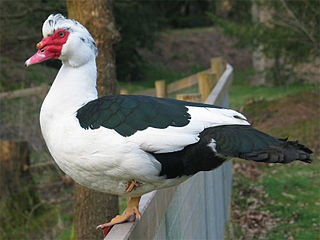
The Muscovy duck is a duck native to the Americas, from the Rio Grande Valley of Texas and Mexico south to Argentina and Uruguay. Feral Muscovy ducks are found in New Zealand, Australia, and in Central and Eastern Europe. Small wild and feral breeding populations have also established themselves in the United States, particularly in Florida, Louisiana, Massachusetts, the Big Island of Hawaii, as well as in many other parts of North America, including southern Canada.

The Pacific black duck is a dabbling duck found in much of Indonesia, New Guinea, Australia, New Zealand, and many islands in the southwestern Pacific, reaching to the Caroline Islands in the north and French Polynesia in the east. It is usually called the grey duck in New Zealand, where it is also known by its Maori name, pārera.
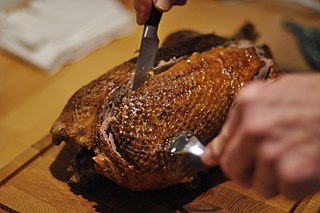
In cooking and gastronomy, duck or duckling is the meat of several species of bird in the family Anatidae, found in both fresh and salt water. Duck is eaten in many cuisines around the world. It is a high-fat, high-protein meat rich in iron. Duckling nominally comes from a juvenile animal, but may be simply a menu name.

The Pekin or White Pekin is an American breed of domestic duck, raised primarily for meat. It derives from birds brought to the United States from China in the nineteenth century, and is now bred in many parts of the world. It is often known as the American Pekin to distinguish it from the German Pekin, a distinct and separate breed which derives from the same Chinese stock but has different breeding. Many of these ducks were reared on Long Island, New York, in the late nineteenth and early twentieth centuries, from which the breed derived its name Long Island Duck.
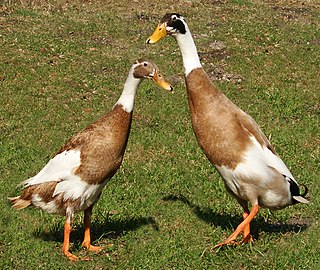
Indian Runners are a breed of Anas platyrhynchos domesticus, the domestic duck. They stand erect like penguins and, rather than waddling, they run. The females can lay as many as 300 to 350 eggs a year. They were bred on the Indonesian islands of Lombok, Java and Bali. These ducks do not fly and only rarely form nests and incubate their own eggs. They run or walk, often dropping their eggs wherever they happen to be. The breed arrived in the Western world in the 19th century; they have since been bred to have a wide variety of colours.
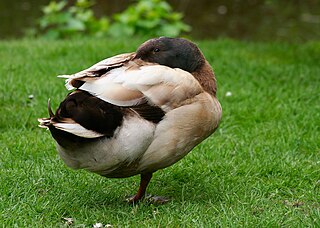
The Campbell is a British breed of domestic duck. It was developed at Uley, in Gloucestershire, England, at the turn of the 20th century; being introduced to the public in 1898 and the Khaki variety in 1901.

The Cayuga is an American breed of domestic duck. It was introduced to the Finger Lakes region of New York State in about 1840, and is named for the Cayuga people of that area. Until the last years of the nineteenth century it was the principal duck reared for meat in the United States. In the twenty-first century it is kept mainly for ornament. The plumage is black with iridescent beetle-green lights.

The Rouen is a heavyweight breed of domesticated duck. Rouens are raised primarily for meat, exhibition, or as general purpose ducks. Since they are not prolific egg layers, Rouen ducks are most commonly bred for their meat. The breed originated in France sometime before the 19th century.

The Crested is a breed of domestic duck, characterised by a crest or tuft of feathers on the head. Ducks of this kind were probably brought from the East Indies to Europe by Dutch ships. The duck may be of any colour; the crest results from the action of an autosomal dominant gene and varies widely in size, from imperceptibly small to a diameter of approximately 13 cm.
The Bali Duck is a lightweight breed of domesticated duck raised primarily for decoration or as pets, although they are good layers. It is similar to the Indian Runner Duck, differing only in having a crest on the top of the head.

The Muscovy or Barbary is the domesticated form of the wild Muscovy duck, Cairina moschata. There are a number of local or regional breeds, and drakes of these are commonly cross-bred with domestic ducks to produce the hybrids called mulards.
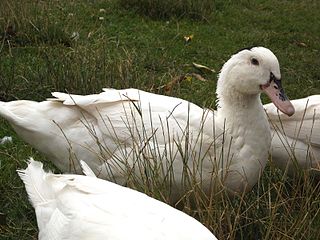
The mulard is a hybrid between two different genera of domestic duck: the domestic Muscovy duck and the domestic duck, derived from the wild mallard. American Pekins and other domestic ducks are most commonly used to breed mulards due to the breed's high meat production. Like many interspecific F1 hybrids, mulards are sterile, giving them the nickname mule ducks. While it is possible to produce mulards naturally, artificial insemination is used more often with greater success.
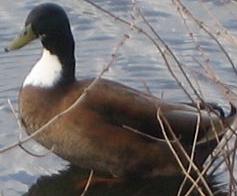
The Duclair duck is a type of Rouen duck named after the town of Duclair in Normandy and traditionally raised in the region for both eggs and meat. Official standards were established for the breed on November 23, 1923.

The German Pekin, ‹See Tfd›German: Deutsche Pekingente, is a European breed of domestic duck. It is commonly called simply Pekin or White Pekin. It is a different breed from the American Pekin, which is also commonly known by the same names. It was bred in Europe from birds originating in China and Japan and is distributed in many European countries.





































